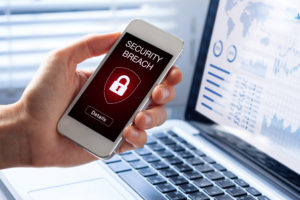
That includes not only safeguarding workstations and servers but also any mobile devices that your team members use for work-related tasks. Many companies have embraced the Bring Your Own Device (BYOD) phenomenon, as it’s convenient and contains tech costs. The U.S. BYOD market is expected to reach $350 billion by 2022, according to research from Global Market Insights.
Mobile Malware: Why You Should Worry
However, more mobile devices in the workplace also means more IT security vulnerabilities. Mobile malware is a significant threat. In 2017, for instance, Symantec recorded a 54 percent increase in new mobile malware variants.
Similarly, in 2018, Kaspersky Lab products and technologies detected 151,359 new mobile banking Trojans, 60,176 new mobile ransomware Trojans, and more than 5 million malicious installation packages.
“Users of mobile devices in 2018 faced what could be the strongest cybercriminal onslaught ever seen,” writes Victor Chebyshev in the Kaspersky malware report “Mobile malware evolution 2018.”
Securing Your Team’s Smartphones: 4 Essential Steps
It seems unlikely that barrage of mobile malware will stop in 2019 (or in the following years). Luckily, there are steps you can take to minimize the chances of a data breach related to mobile devices.
1. Ensure everyone has set up a strong PIN/password for their devices. Locking your smartphone and other mobile devices in some way (whether that involves a PIN or fingerprint/face scanning) will make it less likely that someone else will be able to access the data on it if it gets lost or stolen, according to the Wired article “Smartphone Security 101: The Steps That Matter Most.”
2. Implement proper Mobile Device Management (MDM). This is the No. 1 recommended method for protecting smartphones. An MDM solution allows for centralized management of mobile devices, according to Webroot. Usually, MDM software will allow for the enforcement of security policies, automatic cloud-based updates, remote monitoring and configuration, and logging and reporting for compliance, among other features.
3. Create a plan of action in case something goes wrong. This involves asking what you would do if a device with sensitive data on it gets lost or stolen, if an employee uses their smartphone or another mobile device to access a non-secure network, or if an employee leaves the company and takes mobile devices containing corporate data with them.
4. Secure your WiFi. Safeguarding your WiFi against unauthorized access will also protect your team’s mobile devices while they’re at work. This involves taking steps like using strong passwords and updating firmware regularly. Learn more by reading this blog entry on securing your WiFi. You should also advise your employees not to connect to unsecured networks (e.g., public WiFi) when using phones and other mobile devices with company data on them.
If you’d like to learn more about what you can do to keep mobile devices and the rest of your company’s IT environment secure, our team of cybersecurity experts would be happy to help. We have experience with various cybersecurity solutions from vendors in our partner network (in addition to offering our own multilayered IT security solution) and can help you decide which services and products would best fit your organization’s specific needs.
For more information, call 877-599-3999 or email sales@stratospherenetworks.com.


